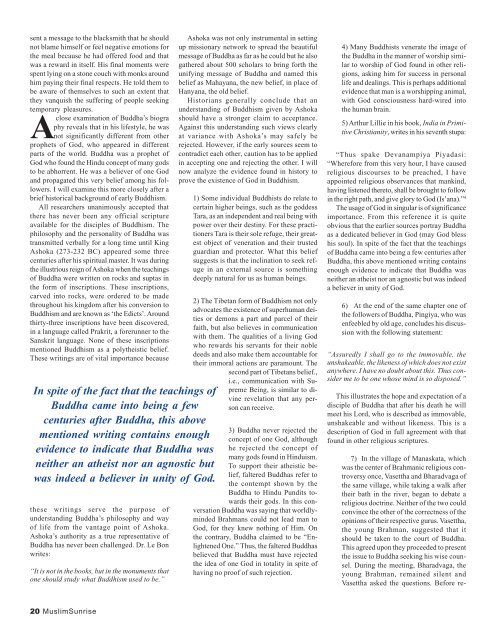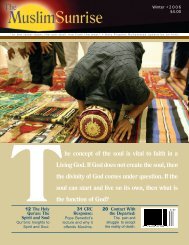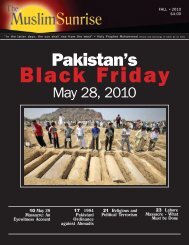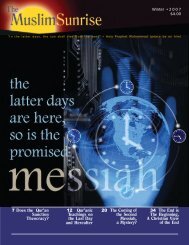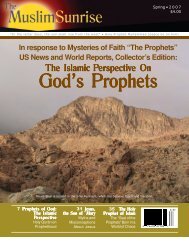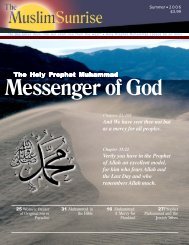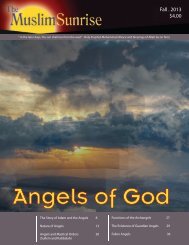sent a message to the blacksmith that he shouldnot blame himself or feel negative emotions forthe meal because he had offered food and thatwas a reward in itself. His final moments werespent lying on a stone couch with monks aroundhim paying their final respects. He told them tobe aware of themselves to such an extent thatthey vanquish the suffering of people seekingtemporary pleasures.Aclose examination of Buddha’s biography reveals that in his lifestyle, he wasnot significantly different from otherprophets of God, who appeared in differentparts of the world. Buddha was a prophet ofGod who found the Hindu concept of many godsto be abhorrent. He was a believer of one Godand propagated this very belief among his followers.I will examine this more closely after abrief historical background of early Buddhism.All researchers unanimously accepted thatthere has never been any official scriptureavailable for the disciples of Buddhism. <strong>The</strong>philosophy and the personality of Buddha wastransmitted verbally for a long time until KingAshoka (273-232 BC) appeared some threecenturies after his spiritual master. It was duringthe illustrious reign of Ashoka when the teachingsof Buddha were written on rocks and suptas inthe form of inscriptions. <strong>The</strong>se inscriptions,carved into rocks, were ordered to be madethroughout his kingdom after his conversion toBuddhism and are known as ‘the Edicts’. Aroundthirty-three inscriptions have been discovered,in a language called Prakrit, a forerunner to theSanskrit language. None of these inscriptionsmentioned Buddhism as a polytheistic belief.<strong>The</strong>se writings are of vital importance becauseIn spite of the fact that the teachings ofBuddha came into being a fewcenturies after Buddha, this abovementioned writing contains enoughevidence to indicate that Buddha wasneither an atheist nor an agnostic butwas indeed a believer in unity of God.these writings serve the purpose ofunderstanding Buddha’s philosophy and wayof life from the vantage point of Ashoka.Ashoka’s authority as a true representative ofBuddha has never been challenged. Dr. Le Bonwrites:“It is not in the books, but in the monuments thatone should study what Buddhism used to be.”Ashoka was not only instrumental in settingup missionary network to spread the beautifulmessage of Buddha as far as he could but he alsogathered about 500 scholars to bring forth theunifying message of Buddha and named thisbelief as Mahayana, the new belief, in place ofHanyana, the old belief.Historians generally conclude that anunderstanding of Buddhism given by Ashokashould have a stronger claim to acceptance.Against this understanding such views clearlyat variance with Ashoka’s may safely berejected. However, if the early sources seem tocontradict each other, caution has to be appliedin accepting one and rejecting the other. I willnow analyze the evidence found in history toprove the existence of God in Buddhism.1) Some individual Buddhists do relate tocertain higher beings, such as the goddessTara, as an independent and real being withpower over their destiny. For these practitionersTara is their sole refuge, their greatestobject of veneration and their trustedguardian and protector. What this beliefsuggests is that the inclination to seek refugein an external source is somethingdeeply natural for us as human beings.2) <strong>The</strong> Tibetan form of Buddhism not onlyadvocates the existence of superhuman deitiesor demons a part and parcel of theirfaith, but also believes in communicationwith them. <strong>The</strong> qualities of a living Godwho rewards his servants for their nobledeeds and also make them accountable fortheir immoral actions are paramount. <strong>The</strong>second part of Tibetans belief.,i.e., communication with SupremeBeing, is similar to divinerevelation that any personcan receive.3) Buddha never rejected theconcept of one God, althoughhe rejected the concept ofmany gods found in Hinduism.To support their atheistic belief,faltered Buddhas refer tothe contempt shown by theBuddha to Hindu Pundits towardstheir gods. In this conversationBuddha was saying that worldlymindedBrahmans could not lead man toGod, for they knew nothing of Him. Onthe contrary, Buddha claimed to be “EnlightenedOne.” Thus, the faltered Buddhasbelieved that Buddha must have rejectedthe idea of one God in totality in spite ofhaving no proof of such rejection.4) Many Buddhists venerate the image ofthe Buddha in the manner of worship similarto worship of God found in other religions,asking him for success in personallife and dealings. This is perhaps additionalevidence that man is a worshipping animal,with God consciousness hard-wired intothe human brain.5) Arthur Lillie in his book, India in PrimitiveChristianity, writes in his seventh stupa:“Thus spake Devanampiya Piyadasi:“Wherefore from this very hour, I have causedreligious discourses to be preached, I haveappointed religious observances that mankind,having listened thereto, shall be brought to followin the right path, and give glory to God (Is’ana).” 4<strong>The</strong> usage of God in singular is of significanceimportance. From this reference it is quiteobvious that the earlier sources portray Buddhaas a dedicated believer in God (may God blesshis soul). In spite of the fact that the teachingsof Buddha came into being a few centuries afterBuddha, this above mentioned writing containsenough evidence to indicate that Buddha wasneither an atheist nor an agnostic but was indeeda believer in unity of God.6) At the end of the same chapter one ofthe followers of Buddha, Pingiya, who wasenfeebled by old age, concludes his discussionwith the following statement:“Assuredly I shall go to the immovable, theunshakeable, the likeness of which does not existanywhere. I have no doubt about this. Thus considerme to be one whose mind is so disposed.”This illustrates the hope and expectation of adisciple of Buddha that after his death he willmeet his Lord, who is described as immovable,unshakeable and without likeness. This is adescription of God in full agreement with thatfound in other religious scriptures.7) In the village of Manaskata, whichwas the center of Brahmanic religious controversyonce, Vasettha and Bharadvaga ofthe same village, while taking a walk aftertheir bath in the river, began to debate areligious doctrine. Neither of the two couldconvince the other of the correctness of theopinions of their respective gurus. Vasettha,the young Brahman, suggested that itshould be taken to the court of Buddha.This agreed upon they proceeded to presentthe issue to Buddha seeking his wise counsel.During the meeting, Bharadvaga, theyoung Brahman, remained silent andVasettha asked the questions. Before re-20 <strong>Muslim</strong><strong>Sunrise</strong>
sponding to the question, Buddha posedsome counter questions.First he asked, “Did any Brahmans versedin the Three Vedas ever see Brahma faceto face?” <strong>The</strong> answer was “No”. <strong>The</strong>nBuddha asked Vasettha, “If any of the Brahmansor their pupils of the previous seven generationshad seen Brahma,” and the answer was again,“No”. <strong>The</strong>n Buddha asked them if they themselvesclaimed that they had ever seen Brahma.Again the answer was, “No”. <strong>The</strong>n he askedVasettha, “If a man, born and brought up inManasakata was asked the way to Manasakata,would that man be in any doubt or difficulty inanswering that question.” Vasettha answered:“Certainly not, Gotama! And why? If the manhad been born and brought up in Manasakata,every road that leads to Manasakata would beperfectly familiar to him.”At this point Buddha expounded:“That man, Vasettha, born and brought up atManasakata might, if he were asked the way toManasakata, fall into doubt and difficulty, butFor people who respond to the call ofGod, irrespective of their caste, the pathto God is made easy for them. For onewho fears God, all human passions suchas anger, jealousy, prejudice etc., cease todominate him. When one transcendsthem, one is likely to imitate Godlyattributes and acquire them.to the Tathagata,” (the fully enlightened one,meaning himself), when asked touching the pathwhich leads to the world of Brahmâ, there canbe neither doubt nor difficulty. For Brahma, Iknow, Vasettha, and the world of Brahma, andthe path which lead unto it. Yea, I know it evenas one who has entered the Brahmâ world, andhas been born within it!” 6Buddha’s argument was that every Godly soulundergoes a great transformation in this verylife and is bestowed a paradise while still in thisworld, the paradise which is none other thanfinding a living God. This living God nourisheshis soul and showers His love which becomesits nurture and it drinks at this fountain of lifeand He enlightens the way and guides themthrough thick and thin. Buddha went on to claimthat he himself was the one who could lead manto God because he had been in communion withHim and had come from Him.Now it is obvious that Buddha did have faithin the existence of one Supreme God and claimedto have come from Him. Buddha knew God betterthan the villagers of Manasakata knew their ownvillage or the roads leading to it. Many greatprophets have made similar claims of witnessinga life of eternity with Him here on earth, evenbefore death transports them to the otherworldlylife. All Divine messengers share this eternal stateof communion with Him, Buddha being noexception. Buddha referred to God as Brahmabecause this was a familiar term to the Hindus,who applied it to the Supreme God among theirgods.As the dialogue continues, the position ismade even clearer.When he had thus spoken, Vasettha, the youngBrahman, said to the Blessed One:“So has it been told me, Gotama, even that theSamana Gotama knows the way to a state ofunion with Brahmâ. It is well! Let the venerableGotama be pleased to show us the way to a stateof union with Brahmâ, let the venerable Gotamasave the Brahman race!” 7Having heard Vasettha,Buddha did not reject hisprayer and aspirationswith reference to Brahmaas being unreal ormeaningless — a definiteproof of his approval ofwhatever he spoke of theBrahma and Hiscommunion with Hischosen ones. For peoplewho respond to the call ofGod, irrespective of theircaste, the path to God ismade easy for them. Forone who fears God, allhuman passions such as anger, jealousy,prejudice etc., cease to dominate him. When onetranscends them, one is likely to imitate Godlyattributes and acquire them. This whole dialogueis worthy of special attention by those who wantto understand Buddha’s attitude towards God.<strong>The</strong> erroneous popular belief aboutBuddhism as a non-Godly religion is largelybased on the teachings presented by Westernscholars. <strong>The</strong>se Western scholars did not botherto conduct their own research but rather heavilyrelied on the translation of Buddha scripture doneby early Buddhists from Pali language. <strong>The</strong>irbaseless atheistic beliefs oozed into the pureteachings of Buddha to pollute it. Moreover,instead of drawing their own inferences directlyfrom a study of reliable Buddhist sources, theyleaned entirely on the beliefs about Buddhismprevailing among the major Buddhist sects. Dr.Gustav Le Bon (1841-1931) writes:“Unfortunately, the study of Indianmonuments has been completely neglected byEuropean scholars. <strong>The</strong> specialists of Indianstudies, through whom we have come to learn ofBuddhism, had never visited India. <strong>The</strong>y hadonly studied this religion in books; an unfortunatetwist of fate made them chance upon the worksof philosophical sects written five or six centuriesafter the death of Buddha, these being absolutelyalien to the religion practiced in reality. <strong>The</strong>metaphysical speculations which had soastonished Europeans by their profundity werein fact nothing new. Ever since the books of Indiahave been better known, these have been foundin the writings of philosophical sects which haddeveloped during the Brahmanic period.” 8Among the best known scholars of India, onlya solitary voice was raised by Hadhrat MirzaGhulam Ahmad (as) in 1899 who, in his bookJesus in India, wrote,“……Buddha also believed in the existenceof the Devil, so he also believed in hell andheaven, in angels and in the Day of Judgment.<strong>The</strong> charge that the Buddha did not believe inGod is pure fabrication. <strong>The</strong> Buddha did notbelieve in Vedanta and in corporeal gods of theHindus. He criticized the Vedas a great deal. Hedoes not believe in the existing Vedas. He regardsthem as corrupt and interpolated.”<strong>The</strong> complete denial of all passions istherefore claimed by Buddhists to be the absolutetruth. Greed for material wealth, power, or eventhe love of others, when unfulfilled, results inthe agony and frustration of the deprived.Similarly, hatred also plays havoc with one’speace of mind. All these forces weaken thespiritual powers of man. This also emphasizesthat because man’s intrinsic nature cannot bechanged and his lust for ever more cannot bestilled, full contentment and satisfaction cannever be achieved without severing all ties withmatter.Instead of attempting to struggle and conquerthe baser motivations and to bring them underthe command of the soul, the soul is advised tobeat a retreat and vacate the arena of life on earth.All that is born out of desire to satisfy one’sego, is lowly, materialistic, ignoble and shouldbe sacrificed for the sake of the ultimate good ofthe same ego. <strong>The</strong> peace achieved through suchan escape amounts to little more than death, i.e.,the negation of life.If the philosophy of absolute self-negation isfollowed to its logical conclusion, it willinevitably lead to the extinction of the humanrace. To ascribe this inspirational gibberish tothe Divinely-enlightened wisdom of Buddha doeshim no honor. This is not the Divine cup ofrevelation from which he drank deep and becameimmortal.Spring <strong>2006</strong> 21


